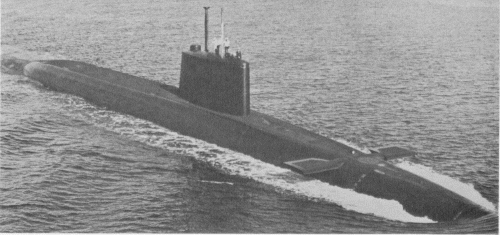
NAVYPEDIA
 Support the project with paypal
Support the project with paypal
Photo

Resolution 1978
Ships
| Name | No | Yard No | Builder | Laid down | Launched | Comp | Fate |
|---|---|---|---|---|---|---|---|
| Resolution | S22 | Vickers-Armstrong, Barrow | 26.2.1964 | 15.9.1966 | 2.10.1967 | for disposal 10.1994 | |
| Repulse | S23 | Vickers-Armstrong, Barrow | 12.3.1965 | 4.11.1967 | 28.9.1968 | for disposal 8.1996 | |
| Renown | S26 | Cammell Laird, Birkenhead | 25.6.1964 | 25.2.1967 | 15.11.1968 | for disposal 2.1996 | |
| Revenge | S27 | Cammell Laird, Birkenhead | 19.5.1965 | 15.3.1968 | 4.12.1969 | for disposal 5.1995 |
Technical data
| Displacement standard, t | |
|---|---|
| Displacement normal, t | 7600 / 8500 |
| Length, m | 109.7 pp 129.5 oa |
| Breadth, m | 10.1 |
| Draught, m | 9.10 |
| No of shafts | 1 |
| Machinery | 2 sets English Electric geared steam turbines, Rolls-Royce PWR1 nuclear reactor |
| Power, h. p. | 15000 |
| Max speed, kts | 20 / 25 |
| Fuel, t | nuclear |
| Endurance, nm(kts) | practically unlimited |
| Armament | 16 Polaris A-3 SLBM (16 UGM-27C), 6 - 533 TT (bow) |
| Electronic equipment | type 1003 radar, type 2001, type 2007, type 2023 sonars, UAB/UAC ECM suite, DCB CCS |
| Complement | 143 |
| Diving depth operational, m | 230 |
Standard scale images

Renown 1969

Resolution 1990

Resolution 1979
Graphics
Project history
At the 1962 Nassau Conference, the momentous decision was taken to transfer responsibility for the United Kingdom's nuclear deterrent from the RAF to the RN, following the cancellation of the airborne Skybolt system. Instead the RN was to build five nuclear ballistic missile sub-names (SSBNs) based broadly on the missile compartment of the US Navy's Lafayette class, with British equipment and machinery, but armed with missiles, tubes and fire control systems supplied from the United States.
A special Polaris Executive was set up to supervise the building of the boats and the creation of training and support facilities, and so successful was the collaboration between the administrative and technical sides that the first boat, Resolution, went on patrol as planned in 1968. With Dreadnought it was the only British post-1945 defence programme to remain within its financial budget. Only one problem was encountered: the figure of five boats was arrived at after a careful study of refit schedules, and when the new Labour Defence Minister, Denis Healey, cancelled the order for the fifth boat (named Ramillies) as a gesture of appeasement, it became difficult to guarantee that one Polaris 'bomber' would remain on patrol at all times. Up to 1992, however, there had officially been no gap in the patrol.
Apart from the use of British equipment and design features from the Valiant class, the main departure from the Lafayette class was the rejection of diving planes on the fin. Although these are standard in USN submarines, British designers maintain that their advantages of better slow-speed control do not outweigh their disadvantages.
Modernizations
1982, Renown; 1984, Resolution; 1986, Repulse; 1988, Revenge: - 16 Polaris A-3 SLBM, type 1003 radar, type 2023 sonar, UAB/UAC ECM suite, DCB CCS; + 16 Polaris A-3TK SLBM (Chevaline warhead), type 1006(1) radar, type 2019 PARIS, type 2047 sonars, UAL(1) ECM suite, DCB/DCG CCS
Naval service
No significant events.
 HOME
HOME FIGHTING SHIPS OF THE WORLD
FIGHTING SHIPS OF THE WORLD UNITED KINGDOM
UNITED KINGDOM SUBMARINES
SUBMARINES RESOLUTION nuclear ballistic missile submarines (4, 1967 - 1969)
RESOLUTION nuclear ballistic missile submarines (4, 1967 - 1969)
